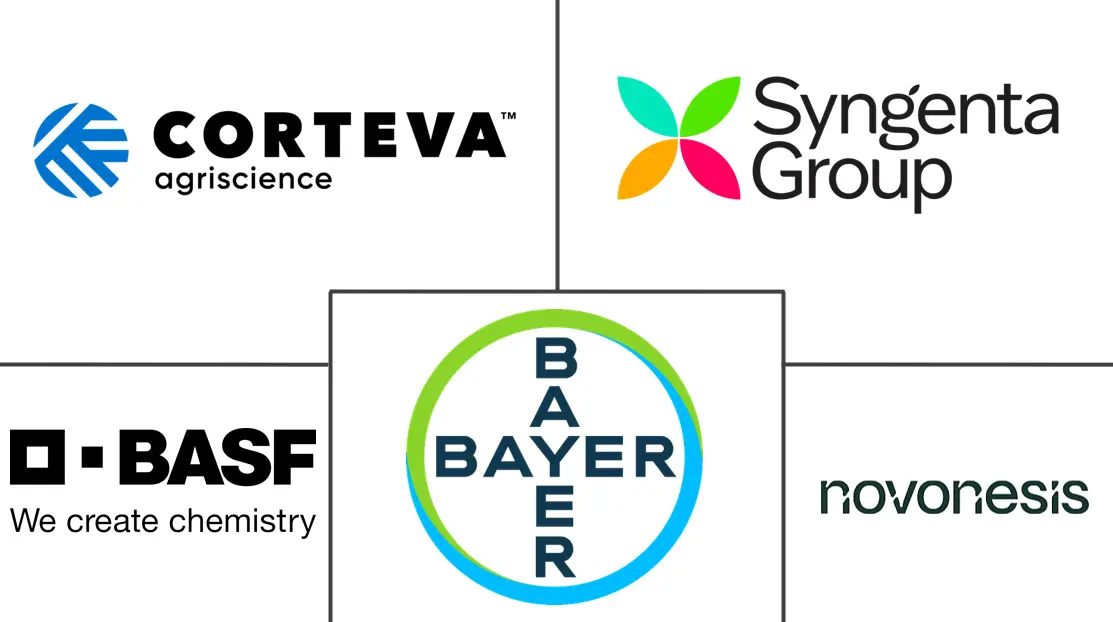Agricultural Inoculants Market Size and Share
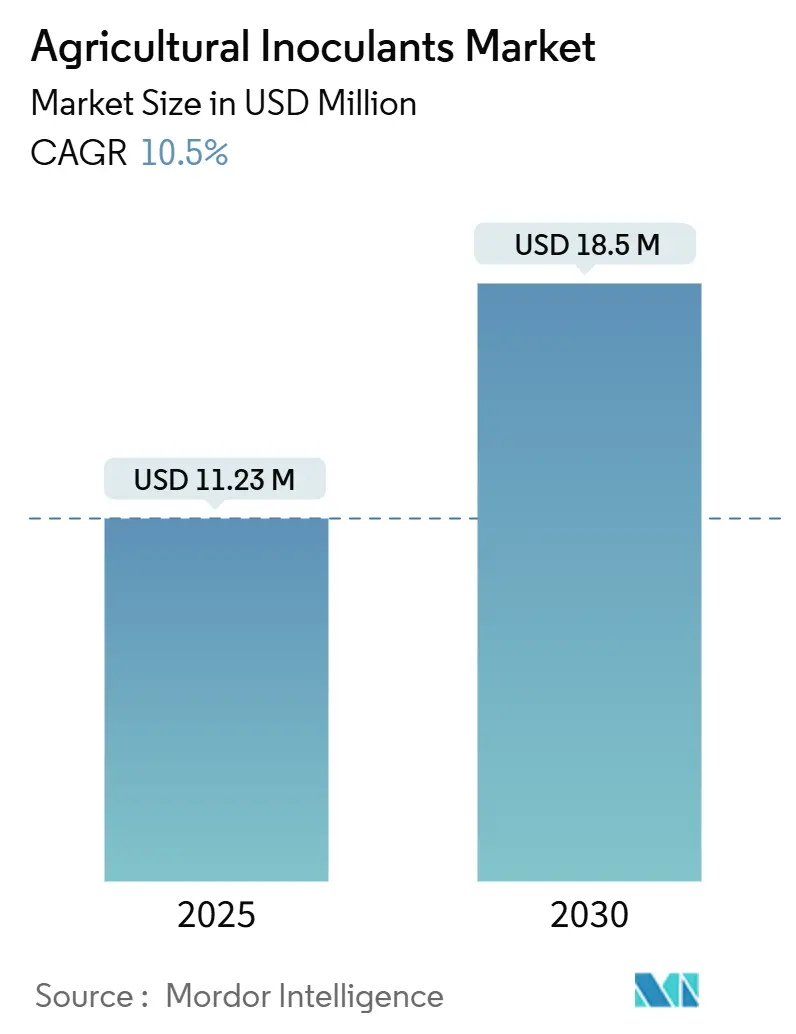
Agricultural Inoculants Market Analysis by Mordor Intelligence
The agricultural inoculants market is valued at USD 11.23 billion in 2025 and is projected to reach USD 18.50 billion by 2030, reflecting a 10.5% CAGR. Growth is now driven by converging factors, including increasing policy pressure to reduce synthetic fertilizer emissions, enhanced carbon credit incentives promoting biological nitrogen fixation, and growing consumer demand for residue-free food that complies with stricter organic standards. The sector has shifted from niche biological inputs to mainstream crop-management tools as farmers recognize the benefits of measurable yield stability and improved soil health. Suppliers capture attractive margins through premium, multi-strain formulations that align with sustainability targets while lowering nutrient costs for growers. Key capital inflows reinforce the uptrend. Venture funding in microbial encapsulation and AI-guided application systems is scaling rapidly, providing start-ups with the resources to commercialize differentiated technologies. At the same time, incumbents accelerate research and development in next-generation delivery methods that extend microbial viability and simplify on-farm use. This dual track of innovation and consolidation signals a market poised for continued expansion as value shifts from commodity single-strain products to integrated biological platforms that deliver verifiable agronomic outcomes.
Key Report Takeaways
- By function, crop nutrition led with 52% revenue share in 2024, while crop protection biologicals are projected to advance at a 10.9% CAGR to 2030.
- By mode of application, seed inoculation accounted for 63% of the agricultural inoculants market share in 2024, while soil inoculation is forecast to expand at a 11.2% CAGR through 2030.
- Among microorganisms, bacteria accounted for a 71% share in 2024, whereas fungi are anticipated to grow at an 11.5% CAGR between 2025 and 2030.
- By crop type, grains and cereals represented a 38% share of the agricultural inoculants market size in 2024, and pulses and oilseeds are projected to grow at a 12.8% CAGR through 2030.
- By geography, North America held the largest regional share in 2024, while South America is forecast to register the fastest growth at a 10.4% CAGR through 2030.
Global Agricultural Inoculants Market Trends and Insights
Drivers Impact Analysis
| Driver | (~) % Impact on CAGR Forecast | Geographic Relevance | Impact Timeline |
|---|---|---|---|
| Shift toward organic certification standards | +1.8% | Global, strongest impact in North America and Europe | Medium term (2-4 years) |
| Shrinking arable land and food-security pressures | +2.1% | Global, acute in Asia-Pacific and the Middle East | Long term (≥ 4 years) |
| Government fertilizer subsidy realignment toward bio-inputs | +1.5% | South America and Asia-Pacific core, spill-over to Africa | Short term (≤ 2 years) |
| Rapid expansion of seed-applied biological consortia | +1.2% | North America and South America, expanding to Europe | Medium term (2-4 years) |
| Venture investment in encapsulation technology for microbes | +0.9% | Global innovation hubs in North America and Europe | Long term (≥ 4 years) |
| Carbon-credit monetization for biological nitrogen fixation | +0.7% | North America and Europe, and emerging in Australia | Long term (≥ 4 years) |
| Source: Mordor Intelligence | |||
Shift Toward Organic Certification Standards
Retailers and consumers now demand residue-free produce, creating a sizable market for inputs that meet stringent organic standards[1]Source: USDA, “National Organic Program — Organic Regulations,” usda.gov. The European Union’s Farm to Fork strategy, aiming for a 50% reduction in chemical pesticide use by 2030, has further contributed to the adoption of microbial solutions across the region[2]Source: European Commission, “Farm to Fork Strategy Targets,” ec.europa.eu. Updated USDA National Organic Program rules clarify acceptable microbial production practices, reducing buyer uncertainty and supporting supplier investment. Organic price premiums ranging from 20% to 40% justify higher upfront costs for biological inoculants. Nevertheless, smaller growers without specialized storage and handling infrastructure face hurdles in maintaining certification throughout the supply chain.
Shrinking Arable Land and Food-Security Pressures
Global arable land per capita fell from 0.38 ha in 1970 to 0.19 ha in 2020, sharpening the focus on yield intensification rather than land expansion[3]Source: Food and Agriculture Organization, “Land Use Indicators 2024,” fao.org. In Asia-Pacific, rapid urbanization amplifies this pressure. Field studies show microbial inoculants can raise yields 4.8-6.2% in low-productivity soils by improving nutrient cycling and soil structure. For regions where land prices exceed USD 10,000 per hectare, biological inputs offer a cost-effective intensification pathway. The benefit grows as synthetic fertilizer prices remain volatile due to energy-market tightness.
Rapid Expansion of Seed-Applied Biological Consortia
Seed treatments are shifting from single strains to consortia that offer nitrogen fixation, phosphorus solubilization, and disease suppression in one pass. Partnerships such as Syngenta and Intrinsyx Bio focus on endophyte combinations that improve nutrient efficiency across multiple crops. Centralized seed-coating plants lower on-farm handling complexity, supporting adoption. Regulatory evaluations, however, become more intricate as agencies must assess inter-microbe interactions rather than single-strain safety.
Venture Investment in Encapsulation Tech for Microbes
Venture funding for microbial encapsulation reached USD 28 million in 2024, signaling investor confidence in delivery innovations that extend shelf life and performance. Technologies such as spray-dried microcapsules and chitosan gel beads protect microbes against temperature swings, critical for tropical markets without cold-chain infrastructure. Biodegradable polymer coatings further address environmental concerns about microplastics while offering controlled release of active organisms. These advances support premium pricing strategies by guaranteeing higher field viability.
Restraints Impact Analysis
| Restraint | (~) % Impact on CAGR Forecast | Geographic Relevance | Impact Timeline |
|---|---|---|---|
| Farmer awareness gaps and on-farm handling complexity | -1.4% | Global, most severe in Africa and Asia-Pacific | Short term (≤ 2 years) |
| Preference for fast-response synthetic fertilizers | -1.1% | Global, strong in North America and Europe | Medium term (2-4 years) |
| Regulatory gray zones for stacked microbial cocktails | -0.8% | Global, varying by jurisdiction | Long term (≥ 4 years) |
| Biological contamination risk in extended supply chains | -0.6% | Emerging markets lacking cold-chain infrastructure | Medium term (2-4 years) |
| Source: Mordor Intelligence | |||
Farmer Awareness Gaps and On-Farm Handling Complexity
Many farmers lack training on microbial storage, viability testing, and application timing. Extension agents often focus on fertilizers and pesticides, leaving a knowledge gap for biologicals. As a result, product mishandling leads to inconsistent performance and skepticism. Brazil’s “nodule crushing” technique, which lets growers propagate rhizobia from root nodules, shows that grassroots innovation can fill extension gaps and lower adoption barriers.
Preference for Fast-Response Synthetic Fertilizers
Synthetic products deliver immediate nutrient availability and predictable yield responses. Field trials of commercial biologicals such as PROVEN 40 showed variable efficacy under different soil and weather conditions. Crop insurance policies and lender covenants often steer farmers toward proven input regimes, reinforcing synthetic dominance. The well-established fertilizer supply chain also lowers transaction friction compared with sourcing and handling microbial products.
Segment Analysis
By Function: Nutrition dominance faces protection disruption
Crop nutrition applications accounted for 52% of 2024 revenue, as nitrogen-fixing and phosphorus-solubilizing microbes replaced portions of synthetic fertilizers. The agricultural inoculants market size for nutrition is projected to expand steadily as rising fertilizer costs encourage the use of biological substitutes. Farmers appreciate documented savings of 15-25% on nitrogen inputs while maintaining yields, resulting in rapid payback periods.
Crop protection biologicals, although contributing a smaller base, are projected to grow at a 10.9% CAGR through 2030. Regulatory crackdowns on chemical pesticides and a surge in resistance issues among major pathogens are accelerating demand. Companies now bundle microbial protectants with nutritional strains, promising holistic coverage from soil to leaf. This convergence pressure forces standalone nutrition providers to broaden their portfolios or risk losing market share to integrated offerings.
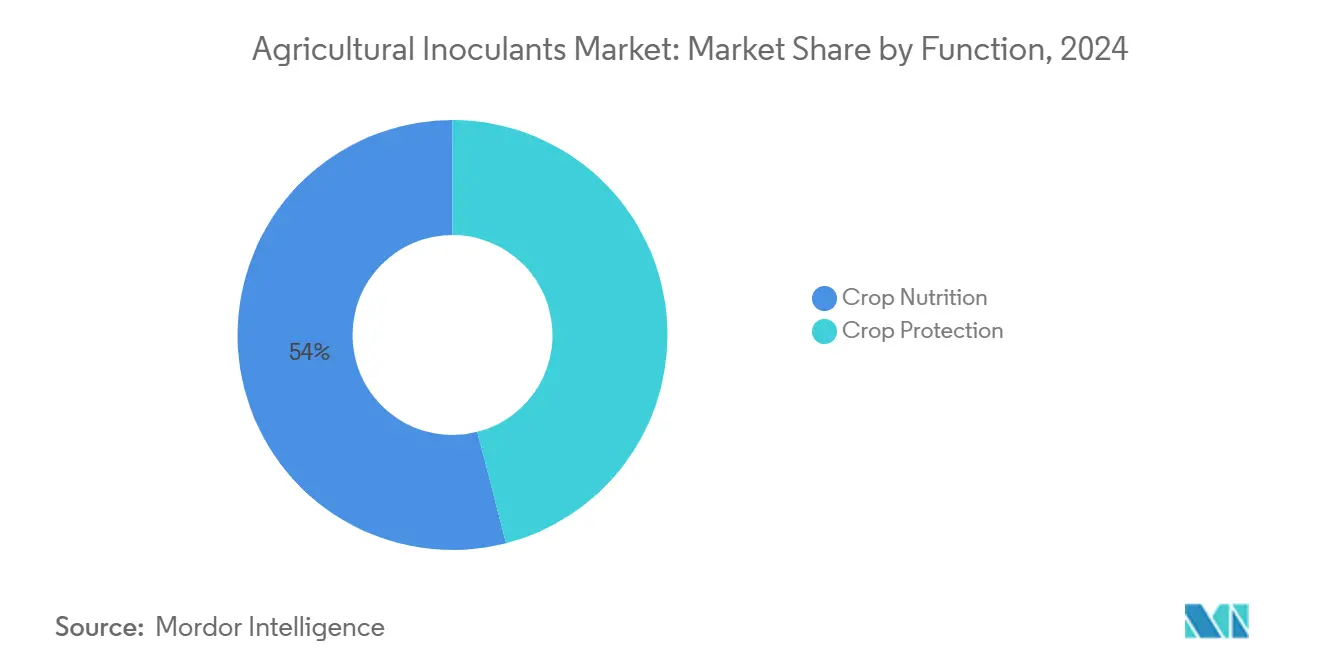
By Microorganism: Bacterial leadership under fungal challenge
Bacteria held 71% of the agricultural inoculants market share in 2024, reflecting decades of rhizobia success in legumes and growing use in cereals. This leadership rests on well-documented efficacy, low cost, and familiarity among regulators.
Fungi are the fastest-growing group, projected at an 11.5% CAGR to 2030. Trichoderma and mycorrhiza strains gain traction for disease suppression and phosphorus uptake. Advances in encapsulation enhance shelf stability, while recent EPA tolerance exemptions smooth approvals[4]Source: Environmental Protection Agency, “Tolerance Exemptions for Microbial Pesticides 2025,” epa.gov. Although bacterial incumbents retain scale advantages, fungal innovators attract investment for premium stress-mitigation benefits.
By Crop Type: Cereal stability meets legume innovation
Grains and cereals held 38% of revenue in 2024, driven by wide acreage and rising biological nitrogen use in maize and wheat. The agricultural inoculants market size in cereals will keep expanding as microbes prove resilient across diverse field conditions.
Pulses and oilseeds lead growth at a 12.8% CAGR. South American soybean fields show 85-90% inoculation rates, proving scalability. Novel strains for canola and sunflower widen the addressable market, and multi-strain packages deliver consistent nodulation in variable soils.
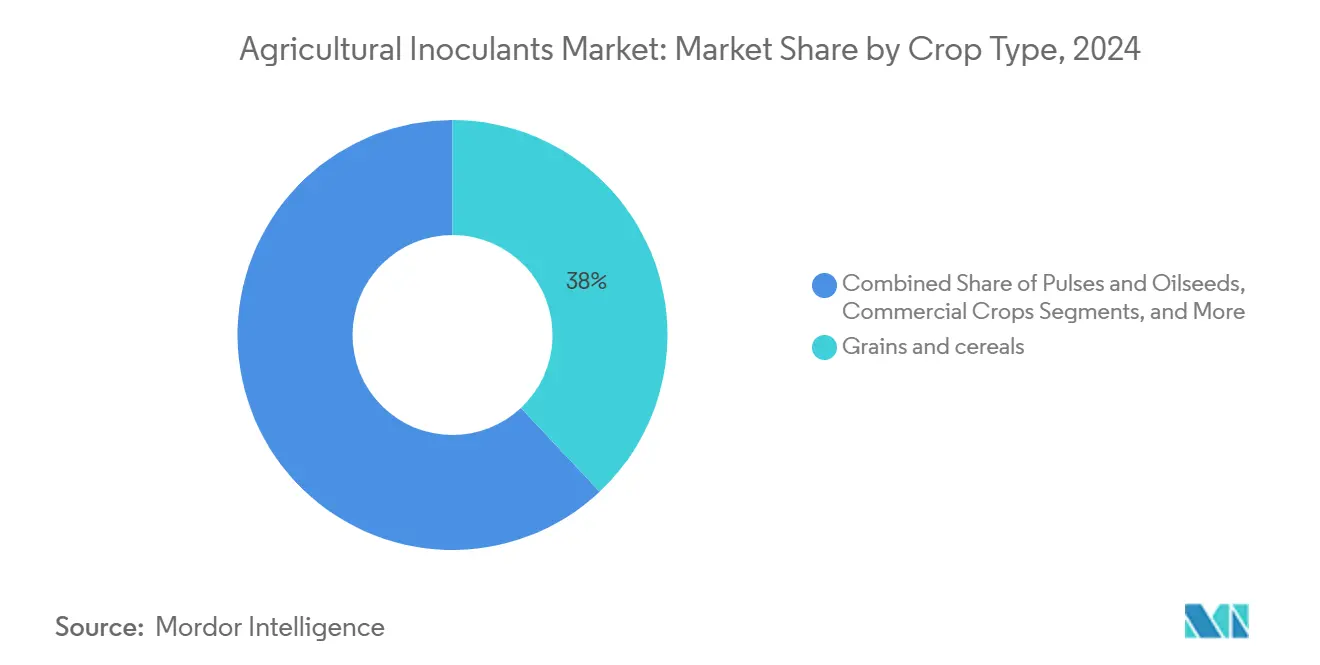
Note: Segment shares of all individual segments available upon report purchase
By Mode of Application: Seed treatment efficiency versus soil precision
Seed inoculation secured 63% of the agricultural inoculants market share in 2024, owing to established seed-coating lines and uniform microbial delivery. Manufacturers add biodegradable polymers that slowly release microbes, shielding them during germination. Centralized treatment minimizes on-farm handling, increasing adoption among large growers.
Soil inoculation is the fastest-growing mode, projected at an 11.2% CAGR through 2030. Precision applicators now place microbes only where soil tests indicate need, improving return on investment. This method is suitable for crops with deep root zones, where seed treatments often underperform. Equipment cost and operator skill, however, limit uptake among smallholders.
Geography Analysis
North America maintained the largest regional share in 2024, supported by robust research and development activity and well-established ag-input distribution networks. The region is anticipated to show a significant growth rate by 2030, but it will trail the global average because many growers remain unconvinced that biologicals can match the reliability of synthetic fertilizers. Regulatory pathways are gradually improving, and recent EPA exemptions for Bacillus and Trichoderma strains shorten the time to market for new products. Continued farmer education and carbon-credit integration could lift adoption across the Corn Belt and Prairie Provinces.
South America is the fastest-growing region with a 10.4% CAGR. Brazil’s National Bio-inputs Program generated BRL 5 billion (USD 1 billion) in sales in the 2023-24 season, up 15%, underscoring strong policy support[5]Source: Brazilian Ministry of Agriculture, “National Bio-inputs Program 2024-25,” agricultura.gov.br. Argentina’s mature soybean inoculation infrastructure complements Brazil’s aggressive new-crop initiatives, creating a continent-wide hotspot. Multinational firms are deepening local partnerships, as shown by ICL’s acquisition of Nitro 1000 and FMC’s pact with Ballagro, to secure regulatory footholds and production capacity.
Asia-Pacific and Africa present emerging opportunities. China’s registration of over 550 microbial pesticide products shows regulatory momentum, while India’s Central Insecticides Board approved 416 biologic agendas in early 2024. In Africa, smallholder-friendly approaches, such as on-farm rhizobia propagation, bypass cold-chain constraints, though broader market development still depends on extension support and access to finance for inoculant application equipment.
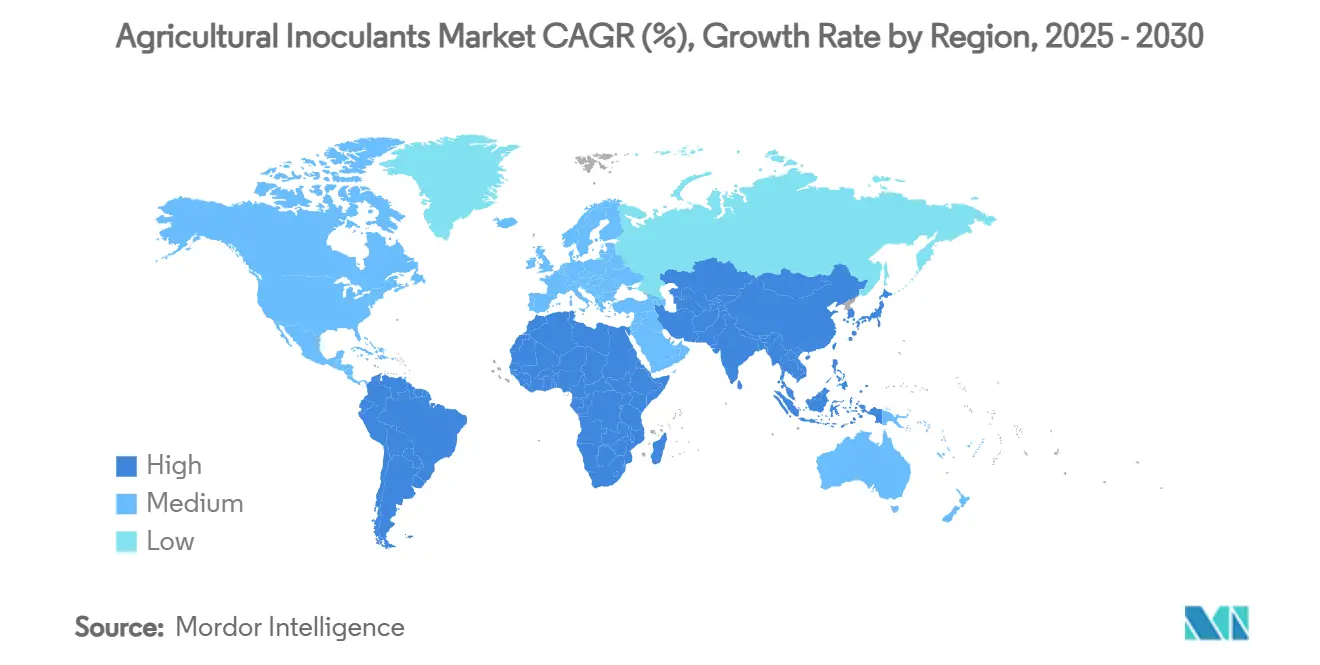
Competitive Landscape
The agricultural inoculants market concentration remains low. BASF leads with a significant share, leveraging an integrated crop-protection approach that bundles biologicals with chemistry and digital tools. Novozymes follows, focusing on strain discovery and scale-up of fermentation. Corteva’s biological platform underpins its Catalyst investment program, which identifies and scouts early-stage technologies for rapid adoption.
Syngenta Group recently acquired Novartis’ natural-product repository to accelerate new-product pipelines. The fifth leading player rounds out the top-tier cohort, but the remaining portion of the market is spread across regional suppliers and specialized biotech firms, highlighting sizable white space for entrants with precision-application devices, advanced encapsulation, or multi-strain consortia.
Strategic patterns emphasize partnership-driven innovation and targeted acquisitions. Established firms utilize their balance-sheet strength to secure proprietary microbe libraries, while start-ups offer nimble research and development in encapsulation and AI-guided application systems. Both groups target the addressable USD 18.50 billion market forecast for 2030, channeling resources into technologies that improve shelf life, simplify farmer handling, and document carbon-credit benefits. As a premium, value-added formulations gain share, competitive intensity is set to rise, with scale and regulatory expertise serving as primary differentiators.
Agricultural Inoculants Industry Leaders
-
BASF SE
-
Novonesis
-
Corteva Agriscience
-
Bayer AG
-
Syngenta AG
- *Disclaimer: Major Players sorted in no particular order
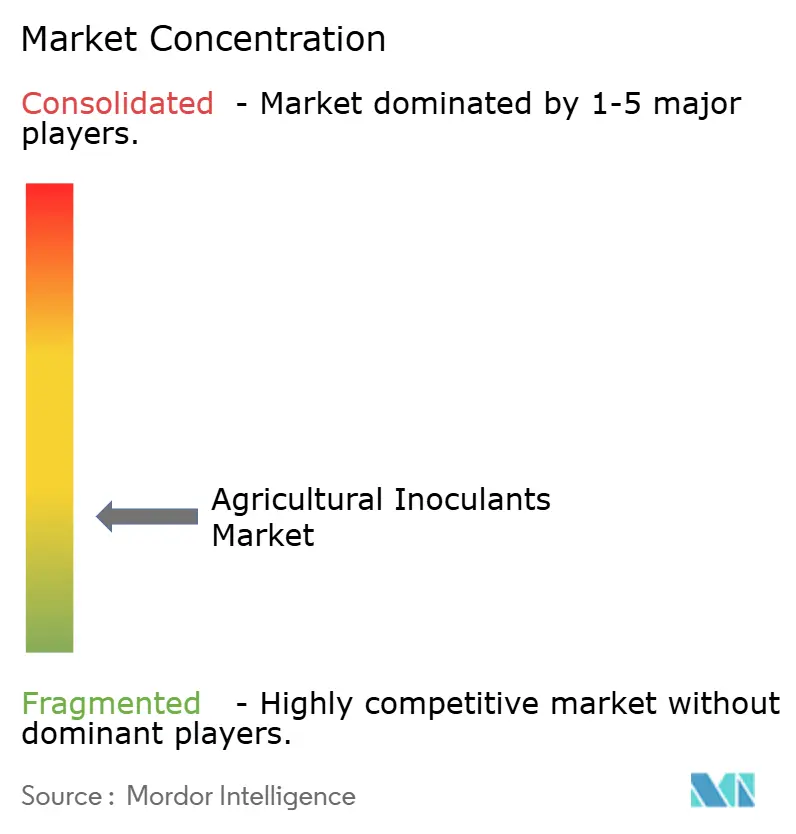
Recent Industry Developments
- January 2023: VerdesianLife Science launched Accolade, a new biological growth enhancement liquid for crops containing Azospirillum Brasilense, a fixing bacterium that can increase root development and secondary lateral root systems, leading to increased nutrient uptake and higher yields.
- September 2022: Syngenta Seedcare and Bioceres Crop Solutions collaborated to bring innovative biological seed treatments, including inoculants, to the market. Through this partnership, Syngenta SeedCare became the exclusive global commercialization distributor of Bioceres' biological solutions, except in Argentina.
- September 2021: In the United States, Novozymes launched five biological solutions, including three biological inoculants, namely BioniQ, TagTeam BioniQPro, and TagTeam BioniQChickpea.
Research Methodology Framework and Report Scope
Market Definitions and Key Coverage
Our study defines the agricultural inoculants market as the value of microbial formulations, chiefly bacteria, fungi or consortia, applied to seed, soil or foliar surfaces to enhance nutrient availability, nitrogen fixation or pest suppression in food and feed crops.
Scope exclusion: products sold solely as silage-specific fermentation aids are not counted.
Segmentation Overview
- By Function
- Crop Nutrition
- Crop Protection
- By Microorganism
- Bacteria
- Rhizobacteria
- Azotobacter
- Phosphobacteria
- Other Bacteria
- Fungi
- Trichoderma
- Mycorrhiza
- Other Fungi
- Other Microorganisms
- Bacteria
- By Mode of Application
- Seed Inoculation
- Soil Inoculation
- By Crop Type
- Grains and Cereals
- Pulses and Oilseeds
- Commercial Crops
- Fruits and Vegetables
- Other Applications
- By Geography
- North America
- United States
- Canada
- Mexico
- Rest of North America
- Europe
- Germany
- United Kingdom
- France
- Spain
- Italy
- Russia
- Rest of Europe
- Asia-Pacific
- China
- Japan
- India
- Australia
- Rest of Asia-Pacific
- South America
- Brazil
- Argentina
- Rest of South America
- Middle East
- Saudi Arabia
- United Arab Emirates
- Rest of Middle East
- Africa
- South Africa
- Kenya
- Rest of Africa
- North America
Detailed Research Methodology and Data Validation
Primary Research
To close gaps, our team interviews agronomists, formulation chemists, input distributors and grower cooperatives across North America, Brazil, India, France and South Africa. These conversations verify real-world adoption rates, typical application doses and forward pricing expectations that desk research alone cannot reveal.
Desk Research
Mordor analysts first screen open datasets from bodies such as FAO FAOSTAT, USDA ERS, Eurostat, ANPII and ICAR; we then layer patent analytics from Questel, shipment traces from Volza, and news archives in Dow Jones Factiva to size planted hectares and gauge inoculant penetration. Company 10-Ks, investor decks, and national biofertilizer guidelines supply ASP clues and regulatory pacing. The sources cited above are illustrative; many additional references inform data cleaning and sense-checking.
Market-Sizing & Forecasting
A hybrid top-down build converts crop acreage into potential treated hectares, applies region-specific penetration and dose multipliers, and prices volumes at weighted average selling prices. Results are cross-checked through selective bottom-up supplier roll-ups and channel checks. Key variables include soybean and corn acreage, organic certification acreage growth, inoculant dose per hectare, average shelf-life related wastage, and regional ASP dispersion. A multivariate regression with acreage, fertilizer price index and organic farmland share drives our 2025-2030 forecast; scenario analysis adjusts for disruptive regulation or drought events.
Data Validation & Update Cycle
Outputs undergo variance checks versus historical trade, are peer-reviewed by senior analysts, and refreshed every twelve months, with interim updates triggered by material events (for example, a major country-level registration change).
Why Mordor's Agricultural Inoculants Baseline Earns Trust
Published figures often diverge because each publisher chooses its own functional scope, base year and refresh cadence.
Key gap drivers include differing treatment of silage additives, whether biofertilizer blends are folded in, contrasting ASP escalation paths, and the timing of currency conversions.
Benchmark comparison
| Market Size | Anonymized source | Primary gap driver |
|---|---|---|
| USD 11.23 B (2025) | Mordor Intelligence | - |
| USD 1.10 B (2022) | Global Consultancy A | Counts only inoculant plus silage additives and omits biofertilizer subsegment |
| USD 0.96 B (2020) | Research House B | Older base year and conservative uptake assumptions depress value |
| USD 4.43 B (2024) | Industry Association C | Relies on shipment surveys from limited regions and flat ASP projection |
This comparison shows that Mordor's wider functional scope, yearly refresh and cross-validated pricing produce a balanced, transparent baseline that decision-makers can replicate and defend.
Key Questions Answered in the Report
What is the projected size of the agricultural inoculants market by 2030?
The agricultural inoculants market is forecast to reach USD 18.50 billion by 2030, rising from USD 11.23 billion in 2025.
Which region is anticipated to grow the fastest through 2030?
South America leads growth with a 10.4% CAGR, driven by Brazil’s bio-input policies and Argentina’s mature inoculation infrastructure.
What functional segment currently dominates the market?
Crop nutrition commands 52% of 2024 revenue, primarily due to the widespread use of nitrogen-fixing and phosphorus-solubilizing microbes.
Why are seed treatments popular for inoculant delivery?
Seed treatments leverage existing coating facilities, ensure uniform microbial coverage, and reduce on-farm handling complexity.
How do carbon credits influence the adoption of biological inoculants?
Emerging carbon markets may pay USD 15-50 per ton of CO₂ abated, enabling farmers to offset inoculant costs while meeting sustainability goals.
Page last updated on:
